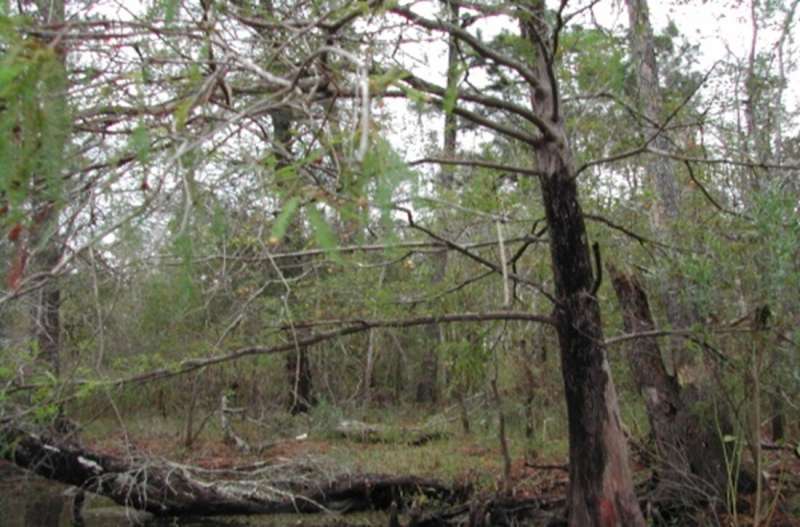This article has been reviewed according to Science X's editorial process and policies. Editors have highlighted the following attributes while ensuring the content's credibility:
fact-checked
proofread
Freshwater management techniques can benefit both inland and coastal wetlands stressed by climate change

Climates are changing in wetland ecosystems around the world. A research collaboration between the U.S. Geological Survey and Clayton State University examined the impact of historical land use on these key environments and proposed employing freshwater delivery techniques developed for inland wetlands to help manage coastal systems.
In a recently published paper, the research team emphasized the impact of human use of land over time, focusing specifically on water delivery to inland wetlands. The researchers explored how inland wetland remediation techniques can be used to mitigate coastal wetlands salinification by increasing freshwater delivery to targeted regions.
The paper was published on June 9 in the Ecosystem Health and Sustainability.
"Both land use and climate change influence wetland ecosystems, especially in coastal landscapes where salinification complicates the problem," said Beth A. Middleton with the U.S. Geological Survey, Wetland and Aquatic Research Center. "While remediation approaches are often better known in inland settings, the solution in coastal wetlands can be similar, particularly if the flow of fresh water from inland rivers to the coast has been altered."
As sea levels rise and storms grow in intensity and frequency, coastal wetlands soak up more salt water via surface water and groundwater sources.
However, the climate change link between sea-level rise and increasing storm activity is only a part of the coastal salinification story. Coastal wetlands also experience rising salinity levels because of reduced freshwater input from inland sources due to drainage canals and water pumping for agriculture and development; geofluid extraction can also cause the ground to gradually cave in—a phenomenon called subsidence.
Eventually, salinification of coastal wetlands can wipe out tree species by reducing sap flow and production, resulting in "ghost forests." Tree mortality can precede peat collapse.
Salinification from damaged coastal aquifers is not an easily addressed problem, according to Jere Boudell from Clayton State University.
"Clearly, in this case, the contributors to the salinification of these coastal wetlands include both climate and land-use change," Boudell said. "With climate warming, the increased usage of groundwater and surface water by humans reduces the fresh water available to natural lands and can lead to the extirpation of foundational species."
Restoring freshwater delivery to wetlands might benefit the conservation of both inland and coastal wetlands during times of climate change.
Techniques used primarily to deliver freshwater flow in inland floodplains may reduce salinification in certain coastal wetlands. While local efforts have been undertaken to re-wet floodplains dried by hydrologic disconnection, there is often little systematic monitoring of outcomes—for example, agricultural floodplains with down-cut channels have been re-wet by creating channel obstructions with objects such as logs or rocks.
Previous studies have shown that vegetation stressed by drought, water extraction, or salinification can be supported by freshwater release and occasional high rainfall events such as hurricanes, which can maintain foundational species and ecosystem function.
If freshwater availability is limited by reduced rainfall and snowpack, or water diversion for municipal and agricultural use, alternative sources of water may be used, according to the paper. For example, declining base flows have been supplemented with treated effluent, stormwater, and irrigation runoff. The discharge did not mimic natural flow regimes due to flood risk concerns, but stream base flows were created or supplemented.
"Water quality and the degree of wastewater treatment will need to be addressed to ensure public and environmental safety for these measures," Boudell said. "However, as these project outcomes illustrate, alternative water sources potentially can maintain and restore riparian ecosystems in water-stressed regions, particularly in urban settings."
The remediation of past land-use damage on the coast to reduce salinity stress can help freshwater species maximize their resilience, growth, and peat-building potential. These approaches can help wetlands have improved function and resilience in the face of climate change.
Future research might explore how to deliver enough fresh water to support coastal wetlands while balancing human's need for fresh water.
"Ultimately, we aim to help managers consider the possibility of addressing coastal salinification problems through freshwater management," Middleton said.
More information: Beth A. Middleton et al, Salinification of Coastal Wetlands and Freshwater Management to Support Resilience, Ecosystem Health and Sustainability (2023). DOI: 10.34133/ehs.0083
Provided by Ecosystem Health and Sustainability




















